ISSN ONLINE(2319-8753)PRINT(2347-6710)
ISSN ONLINE(2319-8753)PRINT(2347-6710)
| Usama A. Nassar 1, 2, Hosam S. El-Samaty 3 Assistant Professor, Department of Architecture and Urban Planning, Faculty of Engineering, Suez Canal University, Ismailia, Egypt 1 Assistant Professor, Department of Engineering Sciences, Community College, Taibah University, Almadinah Almunawarah, Saudi Arabia 2 Assistant Lecturer, Department of Architecture and Urban Planning, Faculty of Engineering, Port Said University, Port Said, Egypt 3 |
| Copyright: © 2015 Chhabra A. This is an open-access article distributed under the terms of the Creative Commons Attribution License, which permits unrestricted use, distribution, and reproduction in any medium, provided the original author and source are credited. |
| Related article at Pubmed, Scholar Google |
Visit for more related articles at International Journal of Innovative Research in Science, Engineering and Technology
Recently, behavioral factors have become an important value, integrated with other values such as function, affecting the built environment. Accordingly, new terms in research, such as environment-behavior studies (EBS), have arisen. These studies describe the relationship between the environment and human behavior and identify its use in the design process. Besides, their emphasis is on fulfilling the needs of users through the correct application of behavioral design criteria. Behavior setting is one of these studies that can be considered as an important attempt to understand the psychology of human behavior in other than intrapsychic or person-centered terms. This type of study considered that the ultimate object of design is to create a form that satisfies behavior. Students’ social behaviors at higher-education buildings, their social interactions, and their gathering areas are among the most significant issues of architectural design. Transition spaces in such type of buildings have an elastic environment; this gives the designer some freedom to express space in a way that is not usually considered. Recent architects stated that a well-designed higher-education transition space (HETS) will help to create an environment of interaction where students can interact with their peers and their professors, thus enhancing the overall performance of such spaces. This performance can be developed by supporting HETS with a variety in functions and activities in order to create an interactive environment that is invaluable to the educational process. The paper will present an analytical approach as an attempt to identify HETS as an efficient ―behavior setting‖ model for better utilization of these spaces. Several samples of international HETS will be described and analyzed to make a better understanding of these spaces and to provide designers with a developed vision about their performance. This proposed vision can be subjected to further researches to identify criteria for assessing HETS performance.
Keywords |
| Transition Space, Behavior Setting, Activity, Movement, Performance, Higher-Education Buildings |
INTRODUCTION |
| Not long ago, we have noticed that many international conferences and organizations are focusing on the idea of how we can understand the real meaning of space. On the other hand, there was a high concern about human aspects in interior spaces and how it affects the design process. Inside the building, transition spaces play an important role in the cultural and social fields. Students’ social behaviors in such spaces, their social interactions, and their gathering areas are among the important issues of architectural programming and architectural design performance [1]. However, recent researches, codes, and guidelines focused on how to provide for the safe and unobstructed movement of people in these spaces, particularly for emergencies and disabilities (such as the British Columbia Building Code and the British Columbia Fire Code Regulations, etc.). Unfortunately, behavioral and psychological considerations have been less regarded in these standards and regulations. Subsequently, this paper will introduce higher-education transition spaces (HETS) as a behavioral phenomenon to recognize the psychology of its users and to identify their social interaction needs. |
II. LITERATURE SURVEY |
| Characteristics of interior transition space have been introduced by former studies and researches. In 1993, Harle' [2] presented the roles and aspects of these spaces within a house in European villages. Later, transition spaces has been Presented as an architectural experience of transfer and been demonstrated by Srivastava [3]. Some researchers confined on studying certain aspects of transition spaces as orientation Fahmy [4], while Pitts [5] discussed the effect of users' behavior on environmental performance of such spaces. Wiechel [6] revealed that HETS should have a variety of functions and diversity of utilizations. Unfortunately, evaluating HETS performance as a space of interacted utilizations has been ignored and neglected according to this literature review, which was the initiative motive to tackle this area of research. |
III. BEHAVIOR SETTING CONCEPT |
| Environment-behavior studies (EBS) is a new term of research related to the systematic examination of relationships between the environment and human behavior and their use in the design process [7]. EBS offers designers and planners a different paradigm for the making of places, rather than focusing on aesthetics and appearance as priority criteria for design. EBS emphasizes meeting the needs of people through the correct use of behavioral design criteria; aesthetics have been always integrated into behavioral criteria but never allowed to dominate the final design [8]. The key concept for the analysis of human behavior in architecture is the behavior setting. Based on the work of the ecological psychologist Roger Barker (1978), a behavior setting can be defined for architectural purposes as a basic unit of analysis of environment-behavior interactions, which includes the following four characteristics [9], as shown in Fig. 1 |
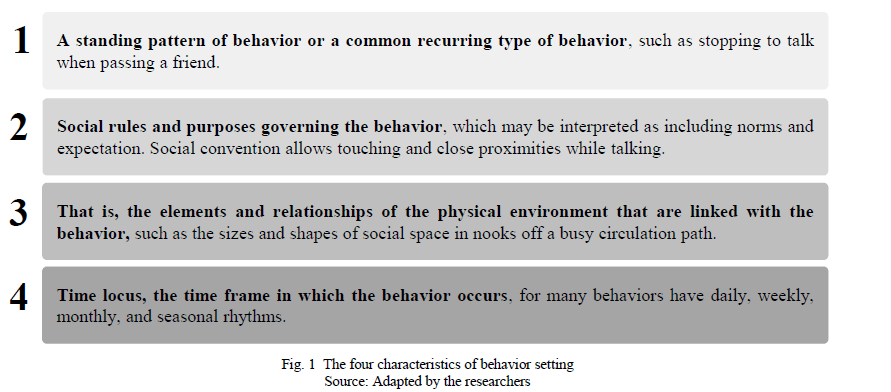 |
| Behavior settings are small-scale social systems, bounded by time and place, composed of people and physical objects (see Fig. 2). Time and place boundaries are important for identifying when and where the behavior setting exists, but people and objects are primary components. People are the most malleable and essential part of the behavior setting. Without at least one person occupant, the setting does not exist. Nevertheless, the interactions among the people and with the physical objects make a behavior setting what it is [10]. |
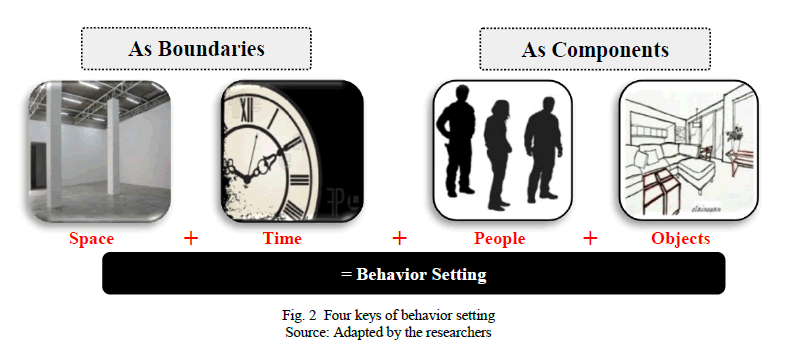 |
IV. ANSWERS FOR QUERIES |
| A. What is the meaning of the term transition spaces? |
| There have been several attempts to define transition space. Everyone has its own notion about this kind of space, such as Peter Eisenman [11], Pierre von Meiss [12], and Suzanne Kent [4]. After reviewing their definitions, the paper suggests the following definition: |
| Transition space is a space that processes a change from one condition to another, is located in-between outdoor and indoor environments, and acts as both buffer space and physical link, other than being functional as circulatory routes for the building. It forms an integral part of any public building and occupies a significant amount of the volume of the building. |
| B. Why higher-education buildings? |
| Social interaction between students and the nature of their tasks encourages informal, diverse, and overlapping activities, affecting the design of these spaces (see Fig. 3). While in other public buildings, the idea of origindestination dominates architects’ concepts. |
 |
| C. Why transition spaces in higher-education buildings? |
| In principle, transition spaces in this type of buildings have an elastic environment because people tend to spend shorter periods of time in them. This allows the designer some freedom to express space in a way that is not usually considered. Recent architects argued that using the design of transition spaces can create a learning environment that is invaluable to the educational process [6]. |
| L. Kahn stated that the corridors would be transferred into classrooms belonging to the students themselves by making them much wider and providing them with alcoves overlooking the gardens. They would become places where fellows meet each other and where the student discusses the work of a professor with his fellow students. He confirms that by allowing classroom time to these spaces instead of passage time from class to class, it would become a meeting connection and not merely a corridor, which means a place of possibilities in self-learning [13]. (see Fig. 4). |
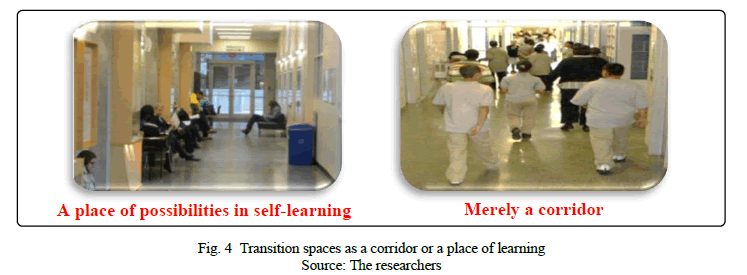 |
V. ANALYSIS AND DESCRIPTION OF DIFFERENT HETS SAMPLES |
| This paper will examine some international higher-education buildings from various universities all over the world. Specified transition spaces of each selected building will be described and analyzed according to the following determining factors: |
| ïÃâ÷ Bases of analyzing process depend on the hypothesis that behavior setting concept forms and controls what happens within these spaces, so: - Description of these spaces will depend on behavior setting components. - Choosing examples depended on a random selection because one of behavior settings’ features is integrity. It means that although the actors and minor props may be different or may change, the pattern of behavior and the critical relationships of the setting remain essentially the same [9]. |
| ïÃâ÷ A variety of functions and tasks will be regarded in selecting higher-education buildings (i.e., lectures, workshops, etc.) and type of universities (i.e., athletic, experimental, etc.). |
| ïÃâ÷ Observation will focus on specified transition spaces such as passage halls, draught lobbies, hallways, and entrance halls, for the following reasons: - It creates the dominant form of transition spaces in universities’ educational buildings. - Richness and variety of activities occur inside these spaces more than others. |
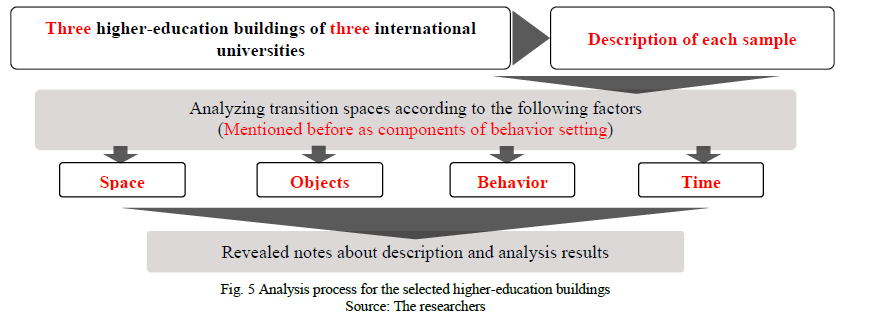 |
| Table 1 shows the list of chosen international universities and some of its higher-education buildings to study according to former bases, while Fig. 9 shows the chosen architectural buildings’ location. |
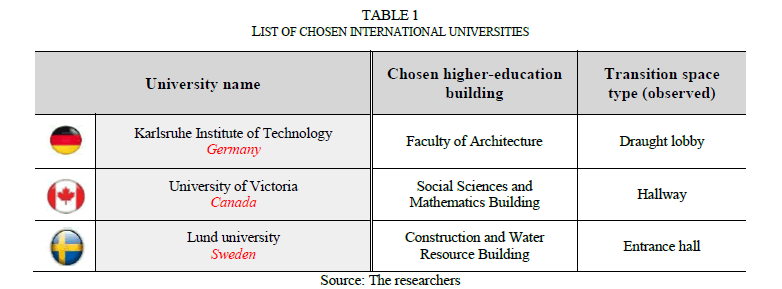 |
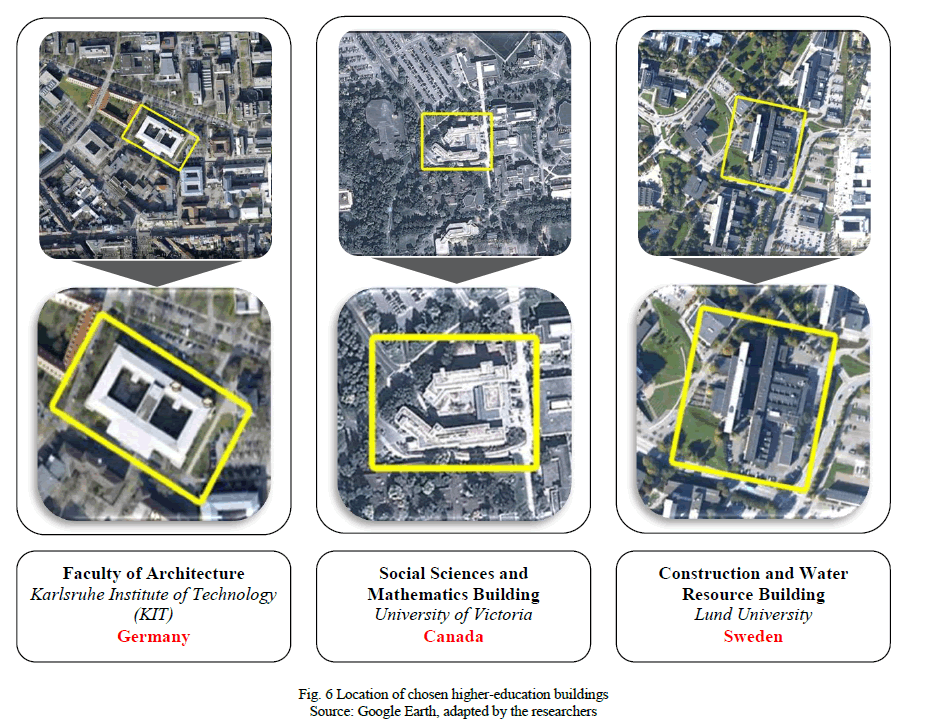 |
| A. First Sample: Karlsruhe Institute of Technology (KIT), Germany |
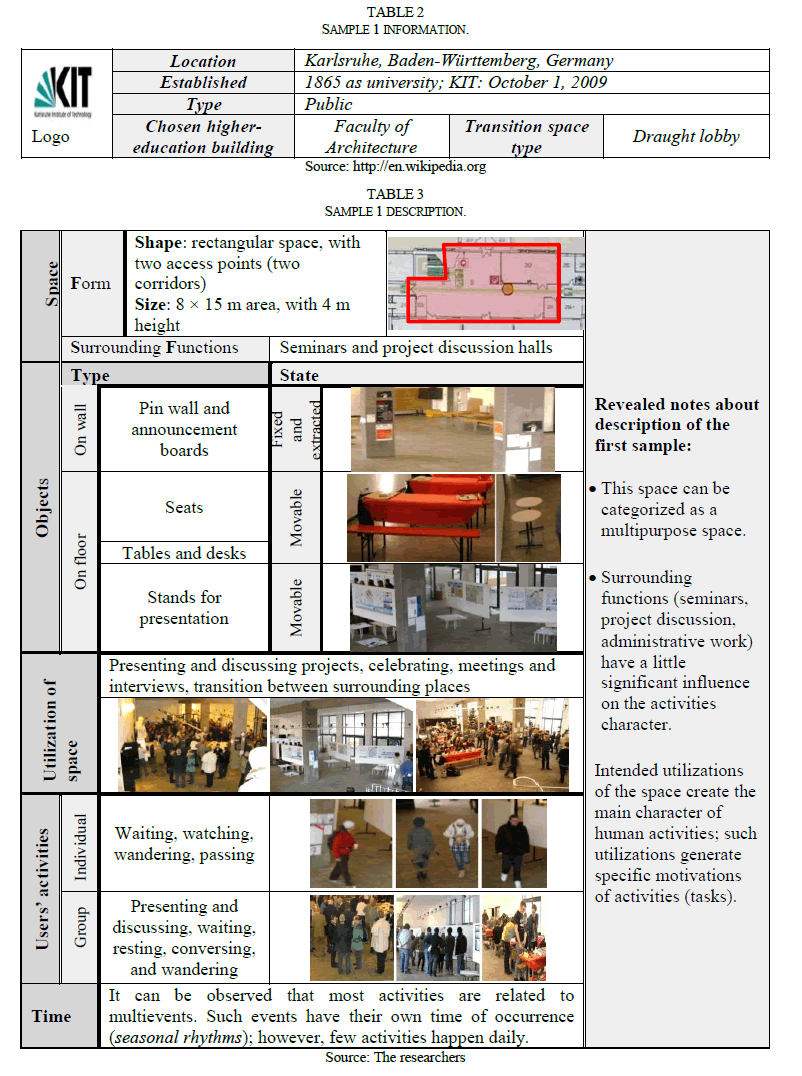 |
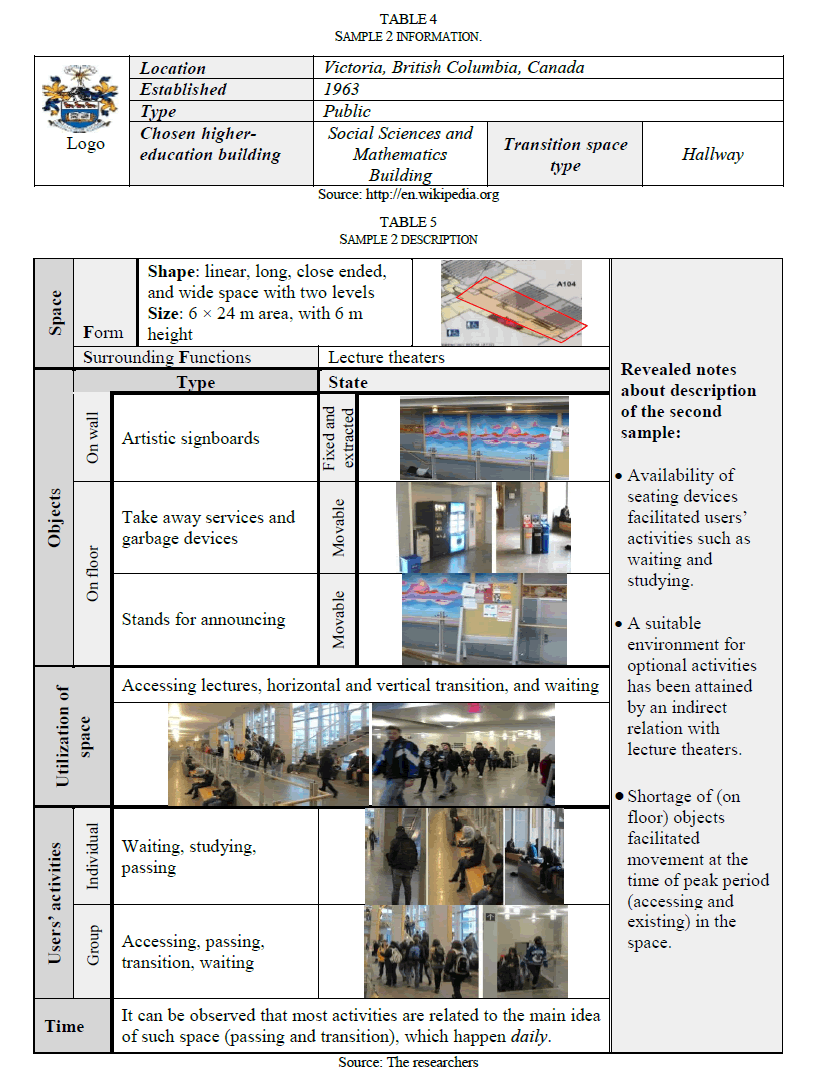 |
| C. Third Sample: Lund University, Sweden |
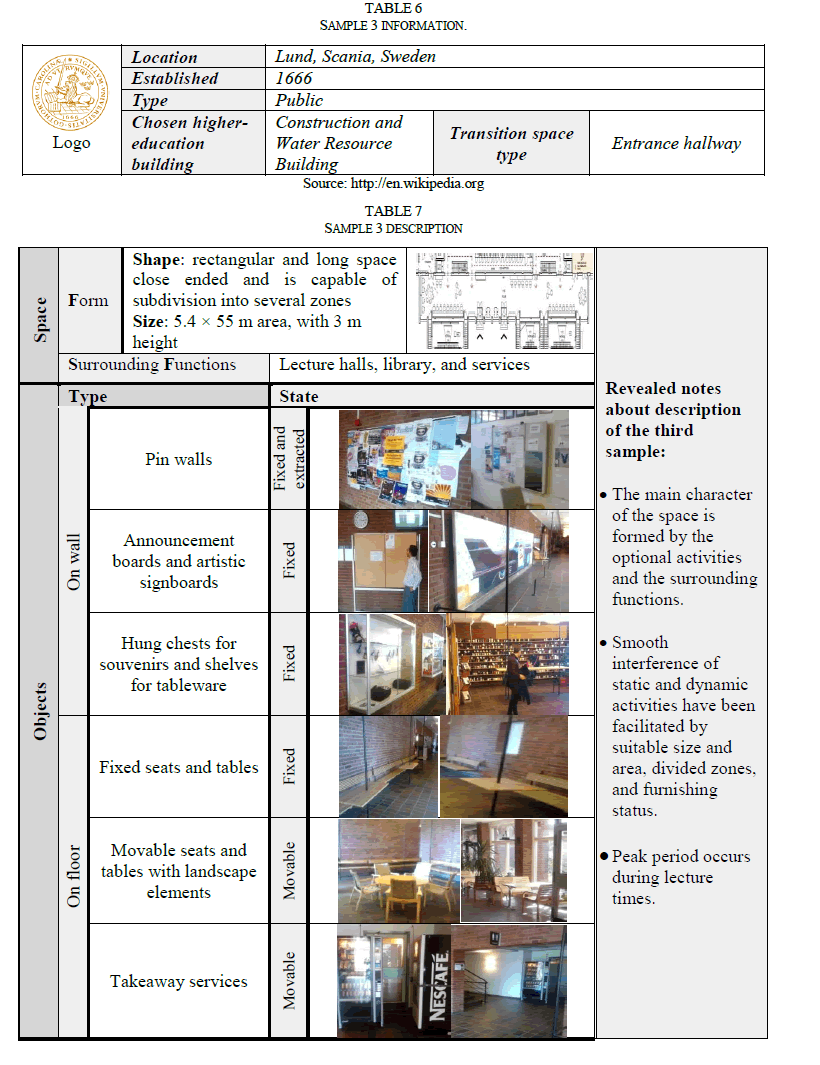 |
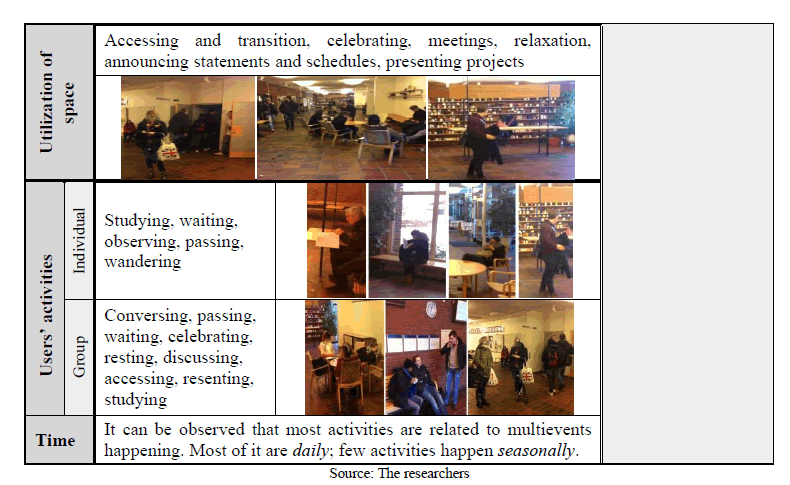 |
VI. RESULTS OF ANALYSIS AND DESCRIPTION |
| A. Utilization of Higher-Education Transition Spaces |
| It is well-known that space utilization is a measure of whether and how space is being used [14]. Other researchers defined it as âÃâ¬Ãâ¢the efficient use of the institution’s physical resources to effectively fulfil its mission and purposeâÃâ¬Ãâ [15]. According to all mentioned above (analysis and description), a classification of higher-education transition spaces (HETS) utilization can be concluded as in Fig. 7 and tables 8 and 9. |
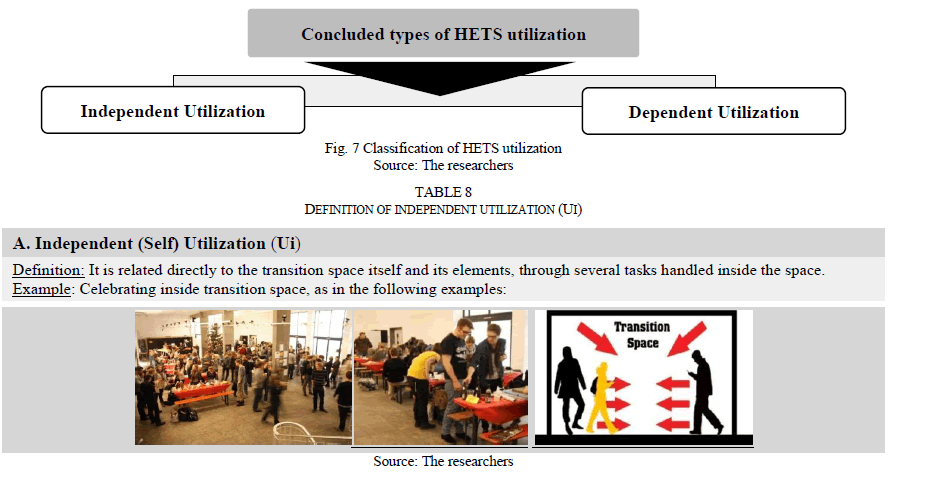 |
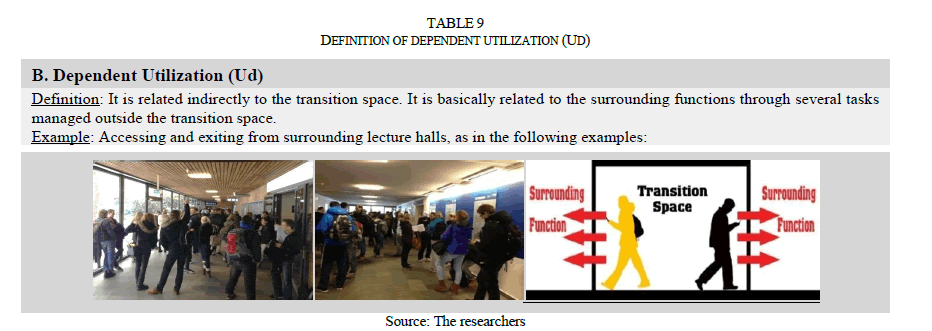 |
| It is obvious that in all cases, HETS is the container of all activities that resulted from the two utilization types, whether directly or indirectly. This means that all activities that happen there should be classified according to the type of utilization. This can be discussed more clearly through the subsequent results. Accordingly, HETS utilization types will be stated accurately in table 10, in order to perform an actual scheduling of the relationship between users’ activities and utilization types. |
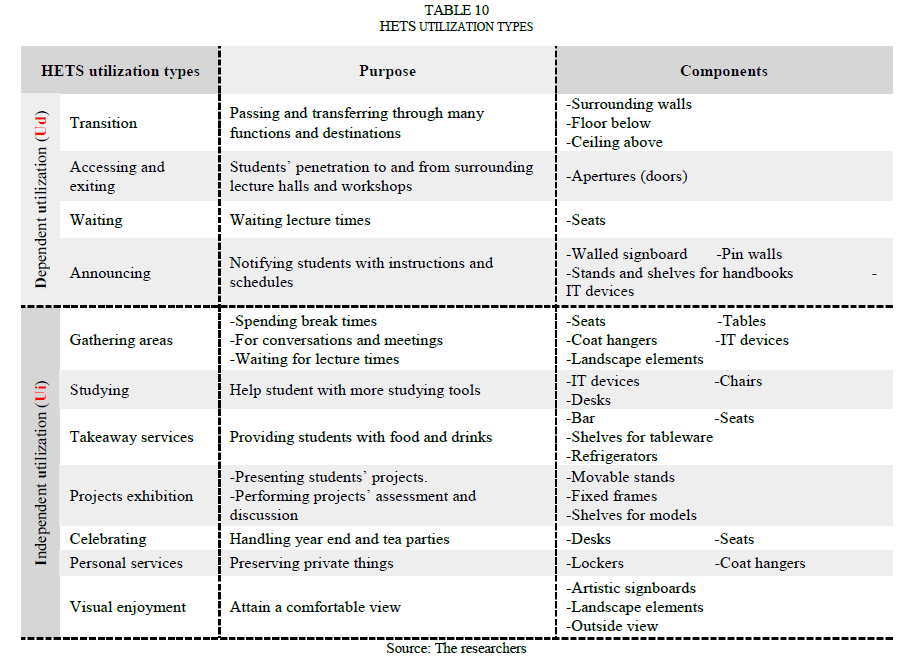 |
| This paper will select some of the HETS utilizations as the essential former of activities and patterns there (refer to table 11). These main HETS utilizations can be determined as follows: |
| ïÃâ÷ All of the dependent utilization (Ud) types, as the common operant in most of the samples |
| ïÃâ÷ The dominant of independent utilization (Ui) types |
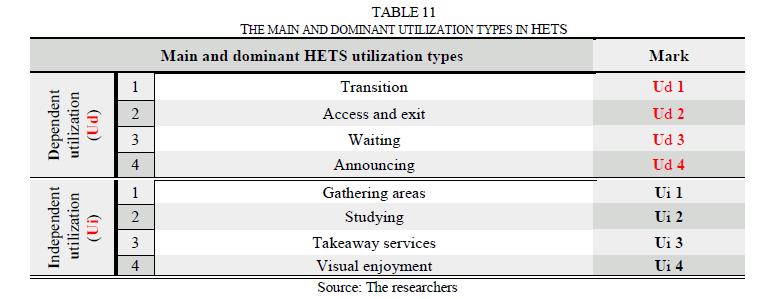 |
| B. Patterns of Activities in HETS |
| Concluded patterns of activities in HETS have been identified with Gehl’s classification of outdoor activities in public spaces. He simplifies and divides outdoor activities in public spaces in the city into three categories, each of which places very different demands on the physical environment (see Fig. 8). |
 |
| These patterns will be reformed—as follows—to fit the interior environment and to accommodate what was observed in HETS according to a previous description and analysis. Accordingly, patterns of activities within HETS can be categorized and defined as shown in table 12. |
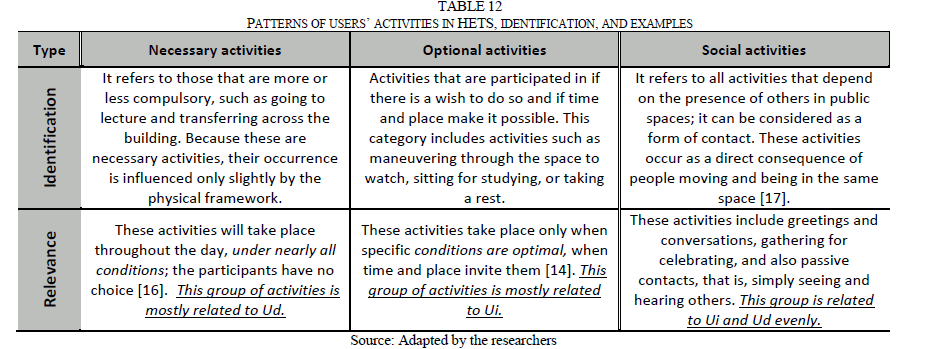 |
| C. Standing Patterns of Behavior (SPB) |
| According to research hypothesis, analysis of HETS will depend on behavior settings components that consist of one or more integrated standing patterns of behavior. The standing pattern is the stable and always-negotiated quasi-object that serves as the central concept or structure of the behavior setting [18]. R. Barker stated, âÃâ¬Ãâ¢Many units of behavior have been identified: reflex, action, molar unit, and group activity are examples. A standing pattern of behavior is another behavior unitâÃâ¬Ãâ. Hence, he described the standing pattern as a bounded pattern in the behavior of men that is a common behavior element among disparate elements, and it has unique characteristics that persist when the participants change [19]. R. Barker also stated, âÃâ¬Ãâ¢For example, in a basketball game, several SPBs—such as the game playing of the team members, the refereeing of the officials, the time keeping of the time keepers, the cheering of the spectators and the sitting, standing and cheering of the spectators—together with other standing patterns make up the integrated complex of behavior patterns that identify the settingâÃâ¬Ãâ. According to this passage and what was observed in previous samples, some points can be concluded: |
| ïÃâ÷ Nature of activities and events happening in HETS conformed with the notion of SPB. |
| ïÃâ÷ Each of HETS’s utilization types brings about one or more particular events and states (SPBs). |
| ïÃâ÷ This group of SPBs makes up the integrated complex of behavior patterns that identify the setting. |
| Hence, table 13 shows the dominant and selected utilization types in HETS (shown in table 11) with its resulting specified standing pattern(s) of behavior. |
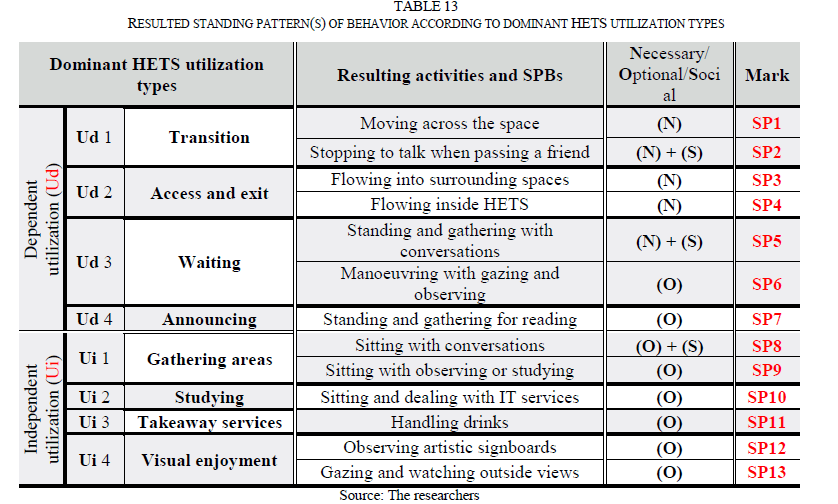 |
VII. HETS AS A BEHAVIOR SETTING MODEL |
| It is obvious that the behavior setting concept is realized and achieved in HETS. Consequently, users’ activities and behavior, performance of these spaces, and its fitness can be characterized through this concept. For instance, the user of HETS is involved and affected by more than one utilization at the time of using space; during the day, every user has to transfer between different and various utilizations according to private needs. Therefore, the use of the space for one user can be formed by a sequence of SPBs. |
| Fig. 9 describes an example for SPB’s existence in an entrance hallway in Lund University, Sweden, showing the overlapping and intersections between these many imbricate SPBs. |
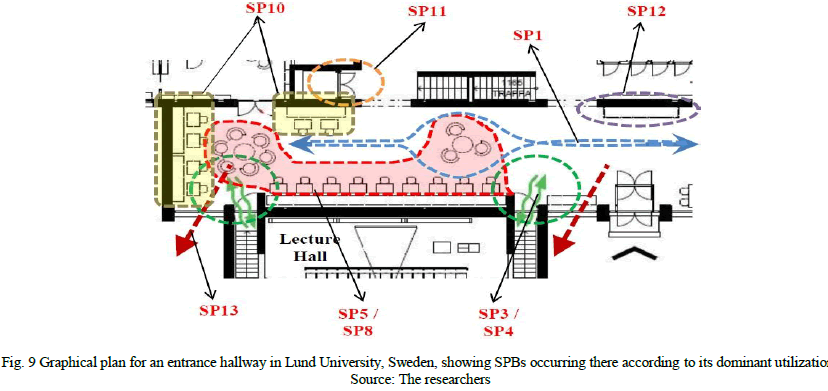 |
| Fitness of HETS as a Behavior Setting According to the behavior setting concept, R. Barker stated, âÃâ¬Ãâ¢A behavior setting consists of one or more standing patterns of behavior-and-milieu, with the milieu circumjacent and synomorphic to the behaviorâÃâ¬Ãâ [19]. Circumjacent means âÃâ¬Ãâ¢surroundingâÃâ¬Ãâ (enclosing, encompassing); the temporal and physical boundaries of the milieu surround the behavior pattern without a break. Synomorphic means âÃâ¬Ãâ¢similar in structureâÃâ¬Ãâ (behavior and the milieu of a behavior setting). The behavioral and somatic components of a behavior setting are not independently arranged; there is an essential fittingness between them. |
 |
| So, for achieving fitness of HETS, fulfilment of users’ needs, activities, and behaviors should be regarded through performance of these spaces [8]. Therefore, a new term, interactive performance, can be introduced for a new vision of HETS and in the way of enhancing its efficiency and fitness. This will help create an interactive environment that is invaluable to the educational process. |
VIII. INTERACTIVE PERFORMANCE OF HETS (RESULTED TERM) |
| A. Definition |
| The term interactive—as a description of performance—indicates the following issues: |
 |
| A dynamic environment creates spaces that people want to experience for longer periods of time. This encourages students to stay in the academic buildings and interact with their professors and peers [6]. |
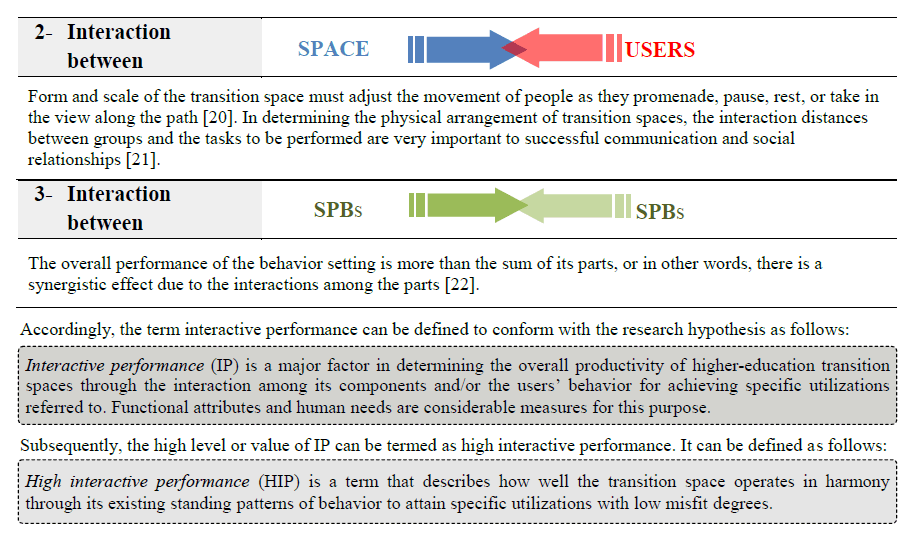 |
| B. Types of Interactive Performance |
| After reviewing the definitions mentioned above, it can be concluded that the overall interactive performance for HETS comprises two main types: functional and psychological (see Fig. 10). These two types are interrelated to HETS utilizations and their SPBs through specific factors. |
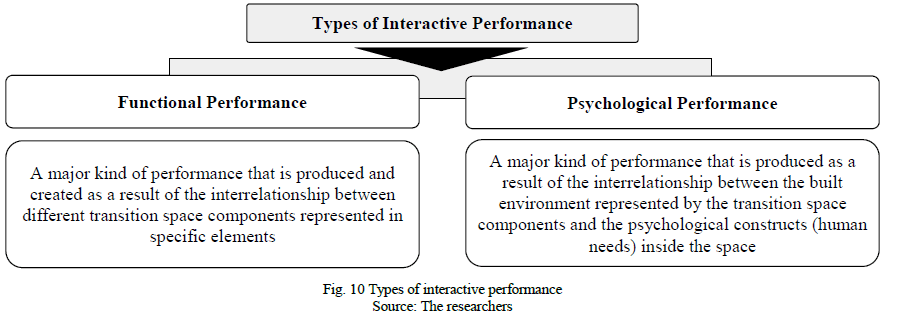 |
| C. Critical Aspects |
| According to previous statements about fitness and the misfit of behavior setting, critical aspect is a term referring to the sequence of SPB factors that has bad impacts on overall performance, functionally and psychologically. This term represents causes of high-degree misfits, not merely the existence of it. Thus, it reveals serious features that obstruct achieving an accepted level of IP in HETS. Thus, it is possible for the setting and its behavior to be mostly in fit with few misfits [6]. as shown in Fig. 11 |
 |
IX. CONCLUSION |
| Based on the research hypothesis (higher-education transition space is an efficient behavior setting model), analysis, and resulting issues, the following points have been obtained and concluded: |
| ïÃâ÷ Users of HETS should be considered—for architects—a part of their environment and never excluded from interaction with their context. |
| ïÃâ÷ Providing HETS with intersected and overlapped SPBs—with low or no misfits—helps in considering HETS as a place of possibilities. This gives a chance for users to sample the unique features that make their particular environment different. Moreover, it helps the user feel free to either make connections or not, to move or not, to stay or not, and to change the situation or not, according to his judgment. |
| ïÃâ÷ The size and shapes of HETS can be designed not only to adjust necessary activities such as users’ flow and waiting for lectures but also to create places for optional activities that require social interactions, such as pausing, resting, or viewing. |
| ïÃâ÷ To develop the overall performance of such spaces, a variety in functions and activities can be achieved in order to create an interactive environment that is invaluable to the educational process. |
| ïÃâ÷ Observing critical aspects and avoiding it is an important issue to have better IP values. |
| ïÃâ÷ For future researchers, this proposed vision for these spaces allows their interactive performance to be assessed using an evaluating scale based on functional and psychological criteria. |
References |
|